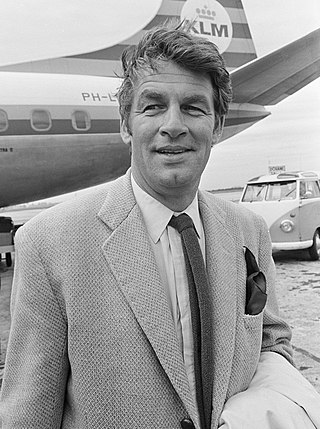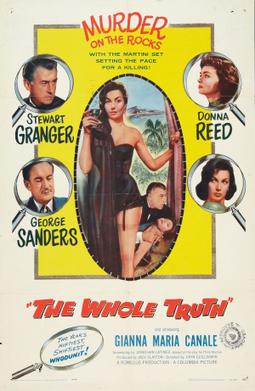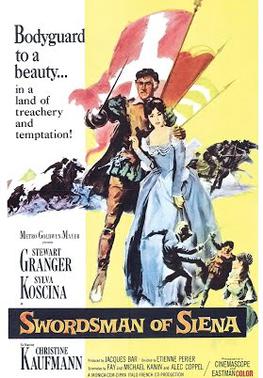
Jean Merilyn Simmons was a British actress and singer. One of J. Arthur Rank's "well-spoken young starlets", she appeared predominantly in films, beginning with those made in Britain during and after the Second World War, followed mainly by Hollywood films from 1950 onwards.

Young Bess is a 1953 Technicolor biographical film made by Metro-Goldwyn-Mayer about the early life of Elizabeth I, from her turbulent childhood to the eve of her accession to the throne of England. It stars Jean Simmons as Elizabeth and Stewart Granger as Thomas Seymour, with Charles Laughton as Elizabeth's father, Henry VIII, a part he had played 20 years before in The Private Life of Henry VIII. The film was directed by George Sidney and produced by Sidney Franklin, from a screenplay by Jan Lustig and Arthur Wimperis based on the novel of the same title by Margaret Irwin (1944).

Stewart Granger was a British film actor, mainly associated with heroic and romantic leading roles. He was a popular leading man from the 1940s to the early 1960s, rising to fame through his appearances in the Gainsborough melodramas.

William Inglis Lindon Travers was a British actor, screenwriter, director and animal rights activist. Prior to his show business career, he served in the British Army with Gurkha and special forces units.

Mike Frankovich, also known professionally as M. J. Frankovich, was an American football player turned film actor and producer. Frankovich was the adopted son of actor Joe E. Brown and his wife, Kathryn.

The Last Hunt is a 1956 American Western film directed by Richard Brooks and starring Robert Taylor and Stewart Granger, with Lloyd Nolan, Debra Paget and Russ Tamblyn. It was produced by Dore Schary at Metro-Goldwyn-Mayer. The screenplay was by Richard Brooks from the novel The Last Hunt, by Milton Lott. The music score was by Daniele Amfitheatrof and the cinematography by Russell Harlan.

Arthur Lubin was an American film director and producer who directed several Abbott & Costello films, Phantom of the Opera (1943), the Francis the Talking Mule series and created the talking-horse TV series Mister Ed. A prominent director for Universal Pictures in the 1940s and 1950s, he is perhaps best known today as the man who gave Clint Eastwood his first contract in film.

Rhubarb is a 1951 film adapted from the 1946 novel Rhubarb by humorist H. Allen Smith. Directed by Arthur Lubin, the screwball noir comedy stars the cat Orangey along with Jan Sterling and Ray Milland. Cinematography was by Lionel Lindon. The supporting cast features William Frawley and Gene Lockhart.

Wicked as They Come is a 1956 British film noir directed by Ken Hughes and starring Arlene Dahl, Philip Carey and Herbert Marshall. It was based on a novel 1950 novel Portrait in Smoke by Bill S. Ballinger. The novel was also adapted for TV in 1950.

Lady Godiva of Coventry is a 1955 American Technicolor historical drama film, directed by Arthur Lubin. It starred Maureen O'Hara in the title role. Alec Harford, the English actor who portrayed Tom the Tailor, died eight months before the film's release.

Escapade in Japan is a 1957 American family adventure film. It was directed by Arthur Lubin and starred Teresa Wright, Cameron Mitchell, Jon Provost and Roger Nakagawa.

Affair with a Stranger is a 1953 American comedy-drama directed by Roy Rowland and starring Jean Simmons and Victor Mature. It was originally to be released as Kiss and Run.

Woman's World is a 1954 American CinemaScope and print by Technicolor drama film about corporate America directed by Jean Negulesco and starring Clifton Webb, June Allyson, Van Heflin, Lauren Bacall, Fred MacMurray, Arlene Dahl and Cornel Wilde. The screenplay concerns three men who compete for the top job at a large company.

The Whole Truth is a 1958 British-American thriller film directed by John Guillermin and starring Stewart Granger, George Sanders, Donna Reed, Gianna Maria Canale and Peter Dyneley. It was based on the 1955 play of the same title by Philip Mackie.

Star of India is a 1954 British-Italian swashbuckling adventure film directed by Arthur Lubin and starring Cornel Wilde, Jean Wallace, Herbert Lom, and Walter Rilla. It was shot at the Riverside Studios in London and on location in Aosta. The film's sets were designed by the art director Cedric Dawe. It was released in the United States in April 1956 by United Artists.

Swordsman of Siena is a 1962 French-Italian adventure film directed by Étienne Périer and Baccio Bandini and starring Stewart Granger, Sylva Koscina and Christine Kaufmann. The film is set in Spanish-controlled Italy during the sixteenth century.

Miss Susie Slagle's is a 1946 American drama film directed by John Berry. It was based on the popular novel by Augusta Tucker. The film was Berry's directorial debut and first starring role for Joan Caulfield.

Joe MacBeth is a 1955 British–American crime drama, directed by Ken Hughes and starring Paul Douglas, Ruth Roman and Bonar Colleano. It is a modern retelling of Shakespeare's Macbeth, set in a 1930s American criminal underworld. The film's plot closely follows that of Shakespeare's original play. It has been called "the first really stand out movie" of Hughes' career.

A Bullet Is Waiting is a 1954 American film noir crime western film directed by John Farrow and starring Jean Simmons, Rory Calhoun, Stephen McNally and Brian Aherne.
Two Sinners is a 1935 film directed by Arthur Lubin.



















